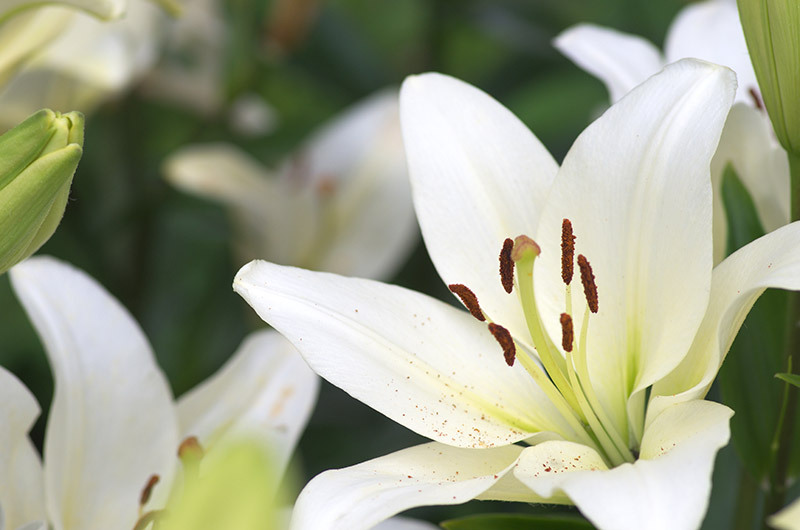Dive into the world of birth month flowers and their intriguing significance
Posted on 02/07/2025
Dive into the World of Birth Month Flowers and Their Intriguing Significance
Are you captivated by the language of flowers and their hidden meanings? Dive into the world of birth month flowers and unlock a world of tradition, sentiment, and beauty. Just as gemstones are linked with each birth month, specific flowers hold unique symbolism for each month. In this comprehensive guide, you'll discover the history, significance, and fascinating stories behind these enchanting blooms--a perfect way to celebrate your birth month or that of someone dear to you.

The Origins of Birth Month Flowers
The tradition of birth month flowers dates back centuries, stemming from ancient Rome and Victorian England, where flowers were a powerful means of communication. Flowers for every birth month carried secret messages, virtues, and traits, making them a charming alternative to birthstones. Today, they act as meaningful gifts and are used to express personal identity, wishes, and connection to nature.
Exploring the Birth Flowers for Each Month
Let's take a captivating journey through the calendar, discovering the birth flower for every month and what these blossoms truly signify. Whether you're seeking thoughtful birthday gifts or simply want to understand the symbolism of your own floral emblem, read on for an in-depth look at birth month flowers.
January: Carnation and Snowdrop
- Carnation: With delicate, ruffled petals, carnations symbolize admiration, love, and distinction. Often gifted during tough times, the carnation embodies resilience as it flourishes even in the winter. Different hues convey different messages--pink for motherly love, white for pure affection, and red for deep admiration.
- Snowdrop: These early bloomers, pushing through the snow, represent hope and new beginnings. They are a reminder that spring--along with renewal and optimism--is just around the corner.
February: Violet and Primrose
- Violet: Associated with modesty, virtue, and faithfulness, the violet's purple petals are a powerful symbol of wisdom and loyalty--qualities often attributed to those born in this month.
- Primrose: Meaning "I can't live without you," the primrose marks youthful love and devotion, making it a romantic emblem for February birthdays.
March: Daffodil
- Daffodil: The sunny daffodil bursts forth at the first sign of spring. Symbolizing rebirth, new beginnings, and unbridled joy, daffodils brighten any March celebration and are considered a harbinger of good fortune.
April: Daisy and Sweet Pea
- Daisy: Universally associated with innocence and purity, the daisy also represents true love and loyal friendship. Its simple beauty is cherished by many.
- Sweet Pea: These fragrant blossoms signify blissful pleasure and gratitude. Often given as a thank-you, sweet peas are a delightful way to celebrate April birthdays.
May: Lily of the Valley and Hawthorn
- Lily of the Valley: These bell-shaped, delicate white flowers denote humility and the return of happiness. Their enchanting aroma has made them a popular bridal flower as well.
- Hawthorn: With its small clusters of blossoms, hawthorn symbolizes hope and supreme happiness--perfect sentiments for the blossoming month of May.
June: Rose and Honeysuckle
- Rose: Its classic elegance and array of colors make the rose a universal symbol of love, beauty, and honor. Each shade holds special meaning--red for love, yellow for joy, and white for innocence.
- Honeysuckle: Representing devoted affection, the sweet scent of honeysuckle is a wonderful tribute to June's warmth and romance.
July: Larkspur and Water Lily
- Larkspur: These vibrant spikes of color symbolize an open heart, positivity, and dignity. Each color tells a different story--from pink (fickleness) to purple (first love).
- Water Lily: Serenity and purity are linked to the water lily, a bloom revered for its tranquil beauty and spiritual significance.
August: Gladiolus and Poppy
- Gladiolus: Tall and striking, gladiolus stands for strength of character, remembrance, and moral integrity. Its name derives from the Latin "gladius," meaning sword--perfect for August's bold spirit.
- Poppy: These vivid flowers convey imagination, eternal sleep, and peace--a duality of passion and tranquility.
September: Aster and Morning Glory
- Aster: Symbolizing wisdom, faith, and valor, asters are often used to express deep emotional love. Their star-like blossoms bring a touch of elegance to early autumn.
- Morning Glory: Emblematic of affection, the morning glory's blooms unfurl with the morning light, making them a poetic representation of new opportunities.
October: Marigold and Cosmos
- Marigold: Infused with the warmth of gold and orange hues, marigolds represent creativity, passion, and peace. Often used in autumnal celebrations, they are linked to warmth and the resilience of the spirit.
- Cosmos: Cosmos flowers signify harmony and order, echoing the balance of nature as the seasons transition.
November: Chrysanthemum
- Chrysanthemum: In many cultures, chrysanthemums denote joy, friendship, and longevity. Their strong, vibrant petals symbolize the life-affirming energy of November.
December: Narcissus and Holly
- Narcissus (Paperwhite): These fragrant winter blooms represent hope and good wishes--fitting for the festive season.
- Holly: With its glossy leaves and bright red berries, holly is a sign of protection and domestic happiness. In many traditions, it is a symbol of the holiday spirit.
The Intriguing Significance of Birth Month Flowers
Why are birth month flowers so significant? These blooms are more than simple embellishments. They are rooted in folklore, history, and even personality analysis. Here's why they continue to enchant and inspire:
- Symbolism and Meaning: Every flower releases a message. The particular birth month flower assigned to you can highlight personal traits such as love, purity, strength, or wisdom. Giving or receiving them shows an understanding of deeper connections and emotional bonds.
- Cultural Traditions: In many parts of the world, celebrating with birth month flowers is a cherished ritual. For example, the Victorians created "floriography," the language of flowers, to send coded sentiments.
- Personalization and Gifting: Selecting flowers that match someone's birth month adds a layer of thoughtfulness, making bouquets or gifts uniquely personal.
- Connection with Nature: Each birth flower is tied to seasonal cycles and natural rhythms, fostering a living connection with nature's growth and beauty.
Choosing, Growing, and Celebrating Birth Month Flowers
Want to incorporate flowers for every birth month into your life? Here are some creative ways to do so:
Gifting with Meaning
- Create birthday bouquets by combining traditional birth month flowers with favorite seasonal blooms.
- Add a personalized message or a note explaining the flower's symbolism.
- Use dried birth month flowers as keepsakes in memory boxes, greeting cards, or jewelry.
Gardening and Growing Your Birth Month Flower
- Plant your birth flower in a home garden or container. This living tribute connects you with your birthday all year round.
- Explore pollinator-friendly varieties to attract butterflies and bees to your garden.
- Research the best growing tips for your flower's specific month and region.
Celebrating with Birth Month Flowers
- Use birth flowers as centerpieces for birthday parties, wedding anniversaries, or meaningful milestones.
- Embellish cakes or pastries with edible (safe!) birth month blossoms.
- Create art, embroidery, or crafts using the image of your birth flower for a personal touch.
Unveiling the Mystery: Less Common Birth Month Flowers
While the classic birth flowers are well-known, regional variations and lesser-known alternatives abound. For instance, some traditions pair April with tulips rather than daisies, or October with calendula instead of marigold. Exploring these alternatives can deepen your appreciation for how cultures worldwide embrace the language of flowers.
- January: In Eastern cultures, plum blossom is celebrated for endurance and hope.
- March: In Japan, the cherry blossom is revered as a symbol of fleeting beauty--and life itself.
- July: Lotus, another midsummer bloom, is a spiritual emblem across Asia.
These variations highlights that the fascination with birth month blossoms is both universal and richly diverse. Whether sticking to traditional lists or embracing regional choices, the message remains the same: flowers are a bridge between the calendar, our identities, and the stories we wish to tell.
Birthday Flowers and Personality: Can Your Birth Flower Reveal Yourself?
As you dive into the world of birth month flowers, you might wonder if the qualities ascribed to your flower resonate with your own personality. While not backed by science, many enjoy reflecting on these correspondences:
- January-born individuals (carnations or snowdrops) are seen as steadfast and hopeful.
- Those born in May (lily of the valley, hawthorn) often prize happiness and humility.
- August birth flowers (gladiolus, poppy) represent boldness and creativity.
Whether or not you see yourself in these symbolic traits, birth flowers provide a charming way of exploring self-awareness and celebrating individuality.

Conclusion: The Enduring Allure of Birth Month Flowers
With so many ways to honor your birth flower for each month, it's no wonder that these traditions have endured through the ages. From their fascinating histories to their personalized meanings and dazzling varieties, birth month flowers offer a poetic way to mark the passage of time and cherish our unique stories.
Next time you celebrate a birthday or special occasion, consider the language of flowers--your unique birth month bloom just might say more than words ever could.
Frequently Asked Questions About Birth Month Flowers
1. Can I give someone their birth month flower as a gift?
Absolutely! Birth flowers make thoughtful and meaningful gifts for birthdays and milestones. Just be sure to explain their significance in a personalized note.
2. Are there alternative birth flowers for each month?
Yes, some cultures and traditions use different flowers. For instance, tulips may be used for April, and calendula for October. Research local customs for more options.
3. How can I find out my unique flower for the month I was born?
Refer to the flower chart above or consult florists--they usually know the traditional birth flower designations.
4. What if I don't like my birth month flower?
Feel free to embrace a cultural variation or choose a flower that has personal meaning to you. The spirit behind birth flowers is about expressing individuality and heartfelt sentiment.
Now that you've explored the world of birth month flowers, which blossom represents you best? Share your birth month flower stories or gift these symbols of love and identity to someone special today!
Latest Posts
Celebrate Birthdays with Timeless Flower Choices
Exotic and elegant blossoms to gift your Valentine
Dive into the world of birth month flowers and their intriguing significance





